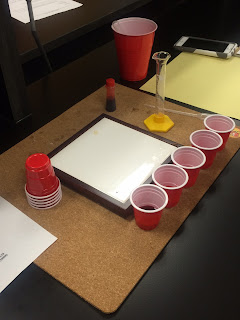In chemistry class, we recently completed a lab where we tested different fruity liquids for their concentration of Vitamin C. We predicted that the liquids would rank as following (1= highest concentration):
1. V8 Juice
2. Unsweet White Grapefruit Juice
3. Apple Juice
4. Pear Nectar
To carry out this experiment, we took 20 drops of each solution, put them into test tubes, combined them with 3 drops of starch, then added drops of iodine until the solution turned and stayed dark blue. Here are all of the pipettes of our test solutions:
Here is what one of the solutions looked like after it turned dark blue due to all of the Vitamin C being used up.
After we completed the lab, we concluded that our concentration predictions were pretty close to the actual results. Here is the actual order of Vitamin C concentration:
1. Unsweet White Grapefruit Juice
2. Apple Juice
3. V8 Juice
4. Pear Nectar
Here are a few links that deal with what we did during this lab:






